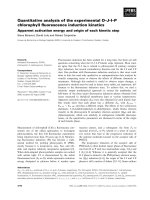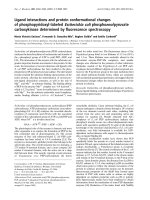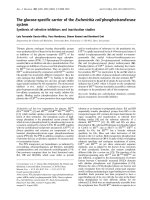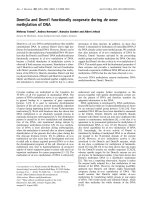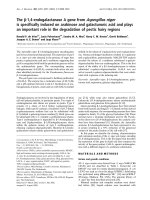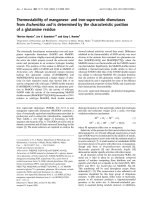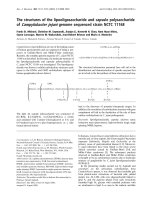Tài liệu Báo cáo Y học: Steady-state kinetics of the glutaminase reaction of CTP synthase from Lactococcus lactis The role of the allosteric activator GTP in coupling between glutamine hydrolysis and CTP synthesis potx
Bạn đang xem bản rút gọn của tài liệu. Xem và tải ngay bản đầy đủ của tài liệu tại đây (229.6 KB, 8 trang )
Steady-state kinetics of the glutaminase reaction of CTP synthase
from
Lactococcus lactis
The role of the allosteric activator GTP in coupling between glutamine hydrolysis
and CTP synthesis
Martin Willemoe¨s
1
and Bent W. Sigurskjold
2
1
Centre for Crystallographic Studies, Department of Chemistry, University of Copenhagen, Copenhagen, Denmark;
2
Department of Biochemistry, August Krogh Institute, University of Copenhagen, Copenhagen, Denmark
CTP synthase catalyzes the reaction glutamine + UTP
+ATP fi glutamate + CTP + ADP + P
i
.Therate
of the reaction is greatly enhanced by the allosteric activator
GTP. We have studied the glutaminase half-reaction of CTP
synthase from Lactococcus lactis and its response to the
allosteric activator GTP and nucleotides that bind to
the active site. In contrast to what has been found for the
Escherichia coli enzyme, GTP activation of the L. lactis
enzyme did not result in similar k
cat
values for the glutami-
nase activity and glutamine hydrolysis coupled to CTP
synthesis. GTP activation of the glutaminase reaction never
reached the levels of GTP-activated CTP synthesis, not even
when the active site was saturated with UTP and the non-
hydrolyzeable ATP-binding analog adenosine 5¢-[c-thio]tri-
phosphate. Furthermore, under conditions where the rate of
glutamine hydrolysis exceeded that of CTP synthesis, GTP
would stimulate CTP synthesis. These results indicate that
the L. lactis enzyme differs significantly from the E.coli
enzyme. For the E.colienzyme, activation by GTP was
found to stimulate glutamine hydrolysis and CTP synthesis
to the same extent, suggesting that the major function of
GTP binding is to activate the chemical steps of glutamine
hydrolysis. An alternative mechanism for the action of GTP
on L. lactis CTP synthase is suggested. Here the binding of
GTP to the allosteric site promotes coordination of the
phosphorylation of UTP and hydrolysis of glutamine for
optimal efficiency in CTP synthesis rather than just acting to
increase the rate of glutamine hydrolysis itself.
Keywords: CTP synthase; isothermal titration calorimetry;
glutaminase activity; allosteric regulation; Lactococcus lactis.
CTP synthase (EC 6.4.3.2) catalyzes the synthesis of CTP
from UTP by amination of the pyrimidine ring at the
4-position. The enzyme has three functionally distinct sites;
the glutaminase site where glutamine hydrolysis occurs, the
active site where CTP synthesis takes place and the allosteric
site that binds GTP. The reaction is thought to proceed via
phosphorylation of UTP by ATP to give an activated
intermediate 4-phosphoryl UTP and ADP [1,2]. Ammonia
then reacts with this intermediate yielding CTP and P
i
as
illustrated in Scheme 1A. Ammonia can either be utilized
directly or be generated from the hydrolysis of glutamine in
a GTP-activated reaction [3,4]. Similar mechanisms to that
shown in Scheme 1A, have been shown now for several
amido transferase enzymes [5–7]. Here the binding of an
already activated substrate, or activation of the substrate on
the enzyme, in this case by phosphorylation, precedes
amination. The overall reaction is as follows:
*
PPPrib
O
HN
N
OPO
3
2-
PPPrib
O
O
HN
N
ATP
NH
3
PPPrib
H
2
N
O
HN
N
OPO
3
2-
PPPrib
NH
2
O
N
N
A
ADP
P
i
PPPrib
O
O
HN
N
PPPrib
H
2
N
O
HN
N
OPO
3
2-
PPPrib
NH
2
O
N
N
B
*
NH
3
ATP
ADP
P
i
PPPrib
H
2
N
O
HN
N
OH
Scheme 1. Proposed mechanisms of CTP synthesis. The box indicates
an expected transition state like structure. * indicates that the amino
donor can either be free ammonia or ammonia generated from
hydrolysis of glutamine.
Correspondence to M. Willemoe
¨
s, Centre for Crystallographic Studies,
Department of Chemistry, University of Copenhagen,
Universitetsparken 5, DK-2100 Copenhagen Ø, Denmark.
Fax: + 45 35320299, Tel.: + 45 35320239,
E-mail:
Abbreviations: ADPNP, adenosine 5¢-[b,c-imido]triphosphate;
ATP-cS, adenosine 5¢-[c-thio]triphosphate; CPS, carbamoyl
phosphate synthase; DON, 6-diazo-5-oxo-norleucine; GDH,
glutamate dehydrogenase; ITC, isothermal titration calorimetry.
Enzymes: CTP synthase (EC 6.4.3.2).
(Received 24 May 2002, revised 29 July 2002, accepted 9 August 2002)
Eur. J. Biochem. 269, 4772–4779 (2002) Ó FEBS 2002 doi:10.1046/j.1432-1033.2002.03175.x
ATP þ UTP þ glutamine ! ADP þ P
i
þ CTP
þ glutamate
CTP synthase from Escherichia coli has been shown to
perform the following two partial reactions:
glutamine ! glutamate þ NH
3
½8 and
ATP ! ADP þ P
i
where the latter reaction takes place only in the presence
of UTP [1]. Levitzki and Koshland originally suggested
a mechanism as shown in Scheme 1B [9]. This mechan-
ism involves another intermediate, a carbinol amine,
formed prior to the phosphorylation step. It was found
that the E.coli enzyme would hydrolyze glutamine at a
steady-state rate similar to the rate of GTP-activated
CTP synthesis, if the enzyme was incubated in the
presence of GTP, UTP and the nonhydrolyzable ATP
analog ADPNP [8]. Furthermore, it was shown that the
fold activation of the glutaminase activity by GTP was
similar to that of the overall CTP synthesis reaction. It
was concluded that the effect of GTP was mainly to
enhance the rate of chemical steps of the glutaminase
reaction. The finding that the k
cat
value was similar for
glutaminase activity in the presence of GTP, UTP and
ADPNP and CTP synthesis with ATP replacing ADP-
NP seems in agreement with the mechanism in
Scheme 1B, but maybe less so with the mechanism in
Scheme 1A.
We have previously characterized the CTP synthase from
Lactococcus lactis [4]. This enzyme appears to be a more
stable tetramer than the E.coli [10], yeast [11] and
mammalian [12,13] enzymes that all require the presence
of UTP and/or ATP to form tetramers. Therefore, the
L. lactis CTP synthase is an attractive candidate for
mechanistic and structure–function studies since equilibria
between different oligomeric forms of the enzyme will not
interfere with the interpretation of the data.
In this research, we have analyzed the steady state
kinetics of the glutaminase reaction of CTP synthase from
L. lactis in order to distinguish between the effects of
GTP on the glutaminase reaction and the CTP synthesis
reaction. The results from this work suggests that there
are major differences between E.coli and L. lactis CTP
synthase with respect to the regulation of glutamine
hydrolysis.
EXPERIMENTAL PROCEDURES
Materials
Bovine GDH, nucleotides, and all other chemicals were
obtained from Sigma, except ATP-cS which was obtained
from Roche. CTP synthase from L. lactis was purified as
described previously [4]. 6-Diazo-5-oxo-norleucine (DON)-
labeled CTP synthase was obtained by incubating overnight
at 25 °C, with 100 lLof8mgÆmL
)1
of enzyme in 50 m
M
Hepes, pH 8.0, 2 m
M
dithiothreitol and 5 m
M
DON. The
protein concentration was determined by the bicinchoninic
acid procedure with reagents provided by Pierce Chemical
Company and with bovine serum albumin as a standard.
The enzyme concentration was calculated using an M
r
of
60 000 per subunit [4].
Spectrophotometric assay of CTP synthesis
and glutaminase activity
Assays were performed at 30 °Cin50m
M
Hepes, pH 8.0,
2m
M
dithiothreitol. For CTP synthesis, the conversion of
UTP to CTP with De
291
¼ 1338 cm
)1
Æ
M
)1
was measured as
described previously [4]. For glutaminase activity, a con-
tinuous coupled assay was used where the glutamate
produced by CTP synthase was oxidized by GDH and
monitored by the reduction of NAD
+
to NADH with
De
340
¼ 6300 cm
)1
Æ
M
)1
as described previously [14]. Unless
otherwise stated, the MgCl
2
concentration was 20 m
M
,the
glutamine concentration was 15 m
M
, and the concentration
of each nucleotide when present in the assay was 1 m
M
.
Isothermal titration calorimetry (ITC) assay
of glutaminase activity and CTP synthesis
CTP synthase at concentrations between 0.029 and 1.16 l
M
was loaded in the reaction cell of an MCS active temperature
compensation isothermal titration calorimeter from Micro-
Cal, LLC (Northampton, MA, USA). The steady-state heat
evolvement from successive injections of glutamine or GTP
was recorded as a displacement of the baseline as illustrated
in Fig. 1A. The power value of the baseline and its
02468101214
30
32
34
Time (min)
Power (µcal s
-1
)
A
B
60 70 80 90 100 110 120 130 140 150
30
31
32
33
Time (min)
Power (µcal s
-1
)
Fig. 1. Isothermal titration calorimetry of the glutaminase activity of
L. lactis CTP synthase. (A) Enthalpogram showing the recording of
steady-state rates for the hydrolysis of glutamine at increasing substrate
concentrations measured as the displacement of the baseline. The peaks
observed at each injection time are derived from the heat of dilution
of glutamine into the reaction cell. (B) The heat generated by hydrolysis
of 0.15 l
M
of glutamine used to determine DH of the reaction.
Ó FEBS 2002 Glutaminase activity of CTP synthase (Eur. J. Biochem. 269) 4773
displacement with each injection was directly obtained from
the data files as the value recorded just prior to the
subsequent injections. Dividing the power with the molar
reaction enthalpy gives the steady-state rate. The assay
conditions were as described above for the spectrophoto-
metric assays. The molar reaction enthalpy, DH,ofgluta-
mine hydrolysis or CTP synthesis under the experimental
conditions as outlined above, was determined by recording
the complete hydrolysis of between 0.05 and 0.15 lmol of
glutamine injected into the reaction cell containing between
1.7 and 17 l
M
CTP synthase and integrating the entire heat
evolvement over time. For the measurement of DH for
CTP synthesis the enzyme was incubated with ATP, UTP,
GTP and MgCl
2
as described above. Although hydrolysis
of ATP will take place under these conditions before and
after injection of glutamine and prior to kinetic experi-
ments, it will not interfere with the measurements as this
hydrolysis is slow and steady-state will prevail for at least
8 h, greatly exceeding the time required for the experiments
(about 20–40 min). The values of DH were found to be
)29.7 ± 0.8 kJÆmol
)1
and )47.3 ± 0.3 kJÆmol
)1
for the
glutaminase reaction and the CTP synthesis reaction,
respectively. The first value agrees well with the value of
Kishore et al.[15].
The steady-state rate, or initial velocity, v
j
for each
injection, j, was determined from
v
j
¼
DP
j
DH½E
ð1Þ
where DP is the change in compensation power of the
calorimeter necessary to maintain the temperature in the
reaction cell upon injection of substrate. This is represented
by a shift in the baseline position. DH is the molar enthalpy
of the reaction under the chosen experimental conditions,
and [E] is the enzyme concentration. The correction for the
enzyme dilution and liquid displacement upon substrate
injection was calculated from
½E
j
¼½E
jÀ1
exp À
V
inj
V
cell
ð2Þ
where V
inj
and V
cell
are the volumes of the injectant solution
and the reaction cell, respectively. The corrections for
the dilution of substrate already present in the reaction
cell upon further substrate injection and for the decrease
in substrate concentration with time were calculated from
½S
j
¼½S
jÀ1
exp À
V
inj
V
cell
À v
jÀ1
t
jÀ1
þ½S
syr
1 À exp À
V
inj
V
cell
ð3Þ
where [S]
j
is the accumulated substrate concentration at the
time of injection j,[S]
j)1
is the substrate concentration at the
time of injection j)1, v
j)1
is the steady-state rate of enzyme
activity prior to injection j, t
j)1
is the time between injection
j)1andj,[S]
syr
is the concentration of the injectant in the
syringe.
Analysis of initial velocity data
Analysis of saturation curves was performed by nonlinear
regression using
v ¼
k
cat
½E½S
K
M
þ½S
ð4Þ
where k
cat
is the turnover number for the enzyme, [S] is the
substrate concentration and K
m
is the Henri–Michaelis–
Menten constant. Partial inhibition of the glutaminase
activity induced by GTP was analysed using a modification
of the equation by LiCata and Allewell [16]
v ¼
k
cat
½Eþk
cat;inh
½Eð½A=I
0:5
Þ
n
1 þ K
A
=½Aþð½A=I
0:5
Þ
n
ð5Þ
where k
cat,inh
is the turnover number for the enzyme fully
complexed with the activator A, with an activation constant,
K
a
, that in turn shows cooperative partial inhibition with an
inhibition constant for half-maximal inhibition, I
0.5
,anda
Hill-coefficient, n. Initial velocity data from the activation of
CTP synthesis or glutaminase activity by GTP as measured
spectrophotometrically was analysed using
v ¼ k
cat;1
½Eþ
k
cat;2
½E½A
K
A
þ½A
ð6Þ
where k
cat,1
and k
cat,2
are the turnover numbers for the
enzyme in the absence of or fully saturated with the
activator, respectively. GTP inhibition of the ammonia
dependent CTP synthesis reaction for DON labeled CTP
synthase was performed using
% Inhibition ¼ 100%
½I
n
K
n
I
þ½I
n
ð7Þ
where K
I
is the concentration of inhibitor that gives rise to
50% inhibition by the inhibitor I and n is the Hill-
coefficient. The standard errors presented are those given by
the computer program (
ULTRAFIT
for the Macintosh vs. 3.0,
BioSoft).
RESULTS
Steady state kinetics using ITC
The use of a calorimetric assay for the study of the L. lactis
CTP synthase proved very useful, since a complete satura-
tion curve for glutamine or GTP could be recorded quickly
and reproducibly without complicating interference from
the presence of added ligands (e.g. the GTP absorbance at
291 nm that prevents the use of higher concentrations than
about 0.3 m
M
GTP in the assay). A calorimetric assay has
been shown recently to be generally applicable to most
enzyme systems [17]. However, the technique requires that
DH for the studied reaction is significantly different from
zero. Another condition that needs to be fulfilled in order to
determine k
cat
foranenzymeisthatDH must be measured
under experimental conditions in which complete turnover
of the substrate takes place. Alternatively, one has to
determine the equilibrium constant of the reaction to
calculate DH. Both the glutaminase reaction and the CTP
synthesis reaction of CTP synthase are virtually irreversible
and present no problem with respect to determining DH.
Figure 1A shows the raw calorimetric data (enthalpo-
gram) obtained for glutamine hydrolysis by CTP synthase.
The complete hydrolysis of glutamine necessary for calcu-
lating the molar enthalpy DH, and subsequently the rate of
4774 M. Willemoe
¨
s and B. W. Sigurskjold (Eur. J. Biochem. 269) Ó FEBS 2002
the reaction, is shown in Fig. 1B. Finally, the calorimetric
data converted to rate data can be fitted as conventional
enzyme kinetic data. From Fig. 2 it can be seen that there is
an excellent agreement between measured initial velocities
independently of the assay method used.
Steady state kinetics of uncoupled-
and CTP synthesis-coupled glutamine hydrolysis
The ATP analogs, ATP-cS and ADPNP, did not serve as
substrates (data not shown) but inhibited the CTP synthesis
reaction (Fig. 3). ADPNP, reported to inhibit the E.coli
enzyme with a K
i
similar to the dissociation constant for
ATP [9], was a poor inhibitor of L. lactis CTP synthase
compared to ATP-cS. On the basis of these results, ATP-cS
was chosen as a binding analog of ATP. CTP synthesis
requires the presence of both the nucleotide substrates ATP
and UTP. When phosphorylation of UTP is hindered by the
absence of ATP, only glutamine hydrolysis takes place.
GTP alone or in combination with UTP and ATP-cS gave a
Glutamine, mM
Glutamine, mM
A
B
0 1 2 3 4
0
0.05
0.1
0.15
0 1 2 3 4
0
1
2
3
ν
, s
-1
ν
, s
-1
Fig. 2. Comparison of the ITC assay with spectrophotometric assays.
Initial velocities obtained from varying glutamine. (A) Glutaminase
(circles) and CTP synthesis (squares). Open symbols represent data
obtained from the assay of glutamate production coupled to NAD
+
reduction by GDH. Closed symbols represent data obtained from
ITC. (B) CTP synthesis in the absence (circles) and presence (squares)
of 0.1 m
M
GTP. Open symbols represent data obtained from spec-
trophotometric measurement of UTP to CTP conversion. Closed
symbols represent data obtained from ITC. In panel (A) and (B) closed
(squares) and closed (circles), respectively, represent the same data-
points.
0 2 4 6 8
0
0.25
0.5
0.75
1
1.25
Relative Activity
Inhibitor, mM
Fig. 3. Inhibition of L. lactis CTP synthase by ADPNP and ATP-cS.
CTP synthesis was measured spectrophotometrically as described in
Experimental Procedures. Inhibition was by ADPNP (circles) and by
ATP-cS (triangles).
Table 1. Kinetic constants for L. lactis CTP synthase from varying glutamine in the presence of various nucleotides
a
.
Reaction
b
Nucleotides present K
m
(m
M
) k
cat
(s
)1
)
Glutaminase none 1.10 ± 0.06 0.084 ± 0.002
Glutaminase GTP
c
1.15 ± 0.05 0.259 ± 0.004
Glutaminase UTP, ATP-cS 1.26 ± 0.09 0.082 ± 0.002
Glutaminase GTP
c
, UTP, ATP-cS 1.0 ± 0.1 0.56 ± 0.02
CTP synthesis UTP, ATP 0.95 ± 0.03 0.139 ± 0.001
CTP synthesis GTP
d
, UTP, ATP 0.75 ± 0.05 2.85 ± 0.06
CTP synthesis GTP
c
, UTP, ATP 0.34 ± 0.03 5.7 ± 0.1
a
Assays were performed by ITC as described in Experimental procedures. Glutamine varied from 0–4 m
M
.
b
Glutaminase refers to
hydrolysis of glutamine without CTP synthesis taking place.
c
The GTP concentration was 1 m
M
.
d
The GTP concentration was 0.1 m
M
.
Ó FEBS 2002 Glutaminase activity of CTP synthase (Eur. J. Biochem. 269) 4775
threefold or sixfold increase in k
cat
, respectively, compared
to the absence of nucleotides, whereas the K
m
for glutamine
was similar for all conditions (Table 1).
Adding ATP and UTP, so that CTP synthesis could take
place, gave a 1.7-fold increase in k
cat
when compared to
glutamine hydrolysis in the absence of nucleotides (Table 1).
The rate of CTP synthesis was dramatically influenced by
the presence of GTP, and 20 and 41-fold increases in k
cat
were obtained with GTP concentrations of 0.1 m
M
and
1m
M
, respectively. However, only a modest decrease in K
m
for glutamine was observed when compared to the absence
of GTP (Table 1).
Allosteric GTP activation of uncoupled-
and CTP synthesis-coupled glutamine hydrolysis
As was already indicated by the results in Table 1 and
discussed above, the kinetics of GTP activation of the
glutaminase half-reaction differed markedly on whether
the reaction was coupled to CTP synthesis or not (Fig. 4A).
The glutaminase activity in the absence of GTP, represented
by k
cat,1
(Eqn 6) is not obtainable with the calorimetric assay
where GTP is varied, since the heat evolved representing this
activity is included in the baseline of the experiment.
Therefore, the assay only measures the rate increase due to
the addition of GTP with a resulting k
cat
that represents
k
cat,2
(Eqn 6). When the ITC assay was used, the basal
glutaminase activity was therefore calculated for the
experimental conditions used for GTP activation on the
basis of the kinetic constants in Table 1, and those obtained
for the glutaminase reaction in the presence of 0.1 m
M
each
of UTP and ATP-cS (data not shown). Apparently, the
value of K
a
, k
cat,1
and k
cat,2
were similar regardless of the
active site being saturated with UTP and ATP-cS(1m
M
each) or not (0.1 m
M
each) (Table 2). However, GTP
concentrations above 1 m
M
appeared to partially inhibit
glutamine hydrolysis when UTP and ATP-cS were present
at only 0.1 m
M
each. This inhibition by GTP seemed to be
relieved by increasing the concentration of UTP and ATP-
cSto1m
M
each (Fig. 4B). In either case, as judged from
the values of k
cat,1
and k
cat,2
, the maximal GTP activation
of uncoupled glutamine hydrolysis was about 14-fold
(Table 2).
At UTP and ATP concentrations of 1 m
M
each, a 49-fold
increase in k
cat
was observed with a concomitant decrease in
K
a
for GTP of about sevenfold compared to uncoupled
glutamine hydrolysis (Fig. 4A and Table 2). GTP-activated
CTP synthesis in the presence of low concentrations
(0.1 m
M
each) of ATP and UTP showed a sevenfold
activation and a K
a
value three orders of magnitude lower
than for uncoupled glutamine hydrolysis where ATP-cS
replaced ATP (Fig. 4C and Table 2).
In another experiment similar to that in Fig. 4C, the GTP
activation of the glutaminase reaction and CTP synthesis
was compared (Fig. 5). In the absence of GTP, the rate of
glutamine hydrolysis was significantly higher than the rate
of CTP synthesis so that the reactions appeared uncoupled
in terms of stochiometry. However, GTP stimulated CTP
synthesis and apparently acted to coordinate or couple the
two reactions. For comparison, the glutaminase activity
calculated from the kinetic constants of GTP activation in
the presence of 0.1 m
M
each of ATP-cS and UTP (Table 2)
is indicated by the straight line in Fig. 5.
L. lactis CTP synthase was incubated with the glutamine
affinity analog, DON, that covalently labels an active site
cysteine residue and thereby prevents the use of glutamine as
amino donor for CTP synthesis [18]. However, even though
the enzyme had no detectable activity with glutamine, the
Fig. 4. GTP activation of L. lactis CTP synthase. Data (A,B) were
obtained by ITC, or by (C) the spectrophotometric CTP synthesis
assay. (A) GTP activation (squares) of CTP synthesis. For comparison
GTP activation of glutaminase activity in the presence of 0.1 m
M
(open circles) or 1 m
M
(closed circles) each of UTP and ATP-cSis
shown within the same concentration range. (B) GTP activation of the
glutaminase activity in the presence of 0.1 m
M
(open circles) or 1 m
M
(closedcircles)eachofUTPandATP-cS. (C) GTP activation of CTP
synthesis at 0.1 m
M
each of UTP and ATP.
4776 M. Willemoe
¨
s and B. W. Sigurskjold (Eur. J. Biochem. 269) Ó FEBS 2002
ammonia-dependent activity was fully retained, as was also
found for the E.colienzyme [9]. GTP has previously been
reported to inhibit the NH
4
Cl-dependent CTP synthesis
reaction of the DON-labeled E.colienzyme, but not the
unmodified enzyme [8]. This was also the case for the
L. lactis enzyme (Fig. 6). When this inhibition was analysed
as a function of the GTP concentration using Eqn 7 we
obtained a K
I
¼ 0.40 ± 0.05 and n ¼ 0.39 ± 0.02, results
that are very similar to those found for the E.colienzyme
[8]. Interestingly, the inhibitory response to GTP binding in
this experiment shows negative cooperativity in contrast to
the activation experiments presented above, where cooper-
ativity is not observed.
DISCUSSION
The original model for the mechanism of GTP activation of
the E.coliCTP synthase was rather complex, involving both
negative and positive cooperativity of GTP binding [8].
However, we have not found cooperativity associated with
GTP activation in these or previous studies [4] of the
L. lactis enzyme. Also, for the E.colienzyme, it appears
that the cooperative phenomena that have been observed
previously are only associated with equilibrium binding, but
seem irrelevant in terms of kinetic activation by GTP [19].
Since there appears to be no effect of GTP on the CTP
synthesis reaction where NH
4
Cl is the amino donor, the
activation by GTP seems exclusively associated with
catalytic properties unique to the utilization of glutamine.
This observation also implies that there is no effect of GTP
on the rate of phosphorylation of UTP by CTP synthase, as
k
cat
for CTP synthesis with NH
4
Cl as amino donor is similar
or higher than for the glutamine-dependent reaction satur-
ated with GTP. These observations, valid for both E.coli[8]
and L. lactis CTP synthase [4], are important when
dissecting the effect of GTP on glutamine-dependent CTP
synthesis.
As mentioned in the Introduction, the GTP activation of
the E.coli enzyme is proposed to be due mainly to an
increase in the rate of glutamine turnover [8]. In agreement
with this proposal the fold activation by GTP for this
enzyme is largely independent of the occupancy of the active
site, i.e. whether the ATP binding analog, ADPNP, and
Table 2. Kinetic constants for L. lactis CTP synthase from varying GTP in the presence of glutamine and the indicated nucleotides.
Reaction
a
Nucleotides present (m
M
) K
a
(mM) k
cat,1
b
(s
)1
) k
cat,2
c
(s
)1
)
Glutaminase UTP 0.1 2.43 ± 0.08 0.078
e
1.20 ± 0.03
(Fig. 4B)
d
ATP-cS 0.1
Glutaminase UTP 1 1.62 ± 0.03 0.076
f
1.054 ± 0.007
(Fig. 4B) ATP-cS1
CTP synthesis UTP 0.1 0.0027 ± 0.0004 0.028 ± 0.005 0.195 ± 0.007
(Fig. 4C) ATP 0.1
CTP synthesis UTP 1 0.22 ± 0.01 0.130
f
6.4 ± 0.1
(Fig. 4A) ATP 1
a
Assays were performed as described in the legend to the indicated Fig. Glutaminase refers to hydrolysis of glutamine without CTP
synthesis taking place.
b
In the absence of GTP.
c
Saturated with GTP.
d
The other kinetic parameters of Eqn 7 were k
cat,inh
¼ 0.353 ±
0.006 s
)1
, I
0.5
¼ 1.65 ± 0.03 m
M
, and n ¼ 2.83 ± 0.1.
e
Value calculated from experiment (data not shown) where glutamine was varied in
the presence of 0.1 m
M
ATP-cS and 0.1 m
M
UTP.
f
Value calculated from the data in Table 1.
GTP, mM
% inhibition
0 0.1 0.2 0.3 0.4
0
10
20
30
40
50
Fig. 6. GTP inhibition of DON-labeled L. lactis CTP synthase. The
data were fitted to Eqn 7 and kinetic constants are given in the text.
GTP, mM
0 0.025 0.05 0.075 0.1
0
0.05
0.1
0.15
0.2
0.25
v, s
-1
Fig. 5. Coupling of glutaminase activity and CTP synthesis at 0.1 m
M
each of UTP and ATP. Spectrophotometrical measurement of CTP
synthesis (squares) and glutaminase activity (circles) was performed as
described in Experimental procedures. The solid line is calculated on
the basis of data (Table 2) from GTP activation of the glutaminase
activity in the presence of 0.1 m
M
each of UTP and ATP-cSandis
shown for comparison.
Ó FEBS 2002 Glutaminase activity of CTP synthase (Eur. J. Biochem. 269) 4777
UTP are present or not. Also, it has been shown that the
E.colienzyme in the presence of GTP, UTP and ADPNP
will hydrolyze glutamine with a k
cat
similar to CTP
synthesis, where ATP replaces ADPNP. This latter obser-
vation suggests that the rate of glutaminase activity of the
E.colienzyme is independent of the UTP-phosphorylation
reaction.
The results presented here for the L. lactis enzyme seem
to indicate significant mechanistic differences between this
enzyme and the E.colicounterpart. From Tables 1 and 2
it is seen that GTP would activate the uncoupled
glutaminase reaction, but not to the extent observed for
CTP synthesis. Even though GTP activation of the
uncoupled glutaminase activity was clearly sensitive to
the occupation of the active site by the nucleotides UTP
and ATP-cS (Fig. 4B), the kinetic constants deviated
significantly from those obtained for CTP synthesis under
similar conditions (Tables 1 and 2). Together, these results
seem to indicate that allosteric binding by GTP alone or in
combination with UTP and ATP-cS, is not capable of
activating glutamine hydrolysis in terms of k
cat
to the level
of CTP synthesis, where ATP replaced ATP-cS. As ATP-
cS could not replace ATP in this coactivation with GTP,
we find it reasonable to suggest that the true coactivator is
the 4-phosphorylated UTP intermediate in a mechanism as
that of Scheme 1A.
From Fig. 4 and Table 2 it can be seen that the effect of
saturating the active site with ATP-cS and UTP was a relief
of partial inhibition by GTP at higher concentrations than
1m
M
(Fig. 4B). The exact mechanism behind this inhibition
cannot be resolved from our data, but apart from this
inhibition the kinetics were similar when ATP-cSandUTP
were present at 1 m
M
or 0.1 m
M
(Table 2). The results
presented in Fig. 4B seem to exclude that the lower fold of
GTP activation of the uncoupled glutaminase reaction was
due to subsaturation with nucleotides binding to the active
site. That CTP synthesis in the absence of GTP occurs with
a k
cat
that is higher than for the glutaminase activity under
similar conditions, except that ATP-cS replaced ATP or in
the complete absence of nucleotides (Table 1), seems to
indicate an activation of the glutaminase reaction by the
substrate nucleotides alone. A similar observation was made
with the E.colienzyme except that UTP and ADPNP also
activated the glutaminase reaction, though not to the same
extent as ATP and UTP [9]. For the L. lactis enzyme, a
plausible explanation may be that 4-phosphorylated UTP
by itself acts as a weak activator of glutamine hydrolysis.
This activation is greatly enhanced by GTP binding to the
enzyme.
From Table 2 it can be seen that the degree of saturation
with ATP and UTP, unlike ATP-cS and UTP, has a large
influence on K
a
for GTP. This correlation of a decrease in
K
a
for GTP with the lowering of the concentration of
nucleotide substrates, has been reported previously [4].
Even though a full description of the mechanism of GTP
activation is not yet available, the difference in K
a
for GTP
observed when ATP replaced ATP-cS appears to involve
structural changes exerted by formation of 4-phosphoryl
UTP, that in turn increases the affinity of the enzyme for
GTP.
An interesting observation was that when ATP and
UTP were present at concentrations that give rise to CTP
synthesis at a rate lower than the rate of glutamine
hydrolysis, GTP still acted as an activator (Figs 4C and 5).
One might have expected that if the role of GTP was
solely to increase the rate of glutamine hydrolysis, there
would have been no effect of adding GTP when the rate of
CTP synthesis was limited by the concentration of
nucleotide substrates, and not hydrolysis of glutamine. In
the narrow concentration interval from 0 to about 2 l
M
GTP, the rate of CTP synthesis is stimulated 3–4-fold from
a level below to the level of uncoupled glutamine
hydrolysis (Fig. 5). This directly illustrates that GTP plays
G N
G N
GN
GN
A
C
B
GTP
Fig. 7. A working model for the structural movements in the L. lactis
CTP synthase monomer. (A) uncoupled glutaminase activity, (B) CTP
synthesis in the absence of GTP and (C) CTP synthesis in the presence
of GTP. (A) Glutamine hydrolysis in the absence of nucleotides takes
place on the enzyme without any large structural changes required. (B)
CTP synthesis in the absence of GTP only occurs at a slow rate due to
an equilibrium between the inactive and active form of the monomer
with respect to CTP synthesis that involves rearrangements of the
monomer that brings together the glutaminase site and the active site.
(C) GTP locks the enzyme in the active form for CTP synthesis and
thereby stimulates the k
cat
of the reaction. Since GTP actually will
activate the uncoupled glutaminase reaction the structure of the
monomer represented by (C) must also include a minor but highly
important rearrangement of sidechains in the active site in response to
the formation of 4-phosphoryl UTP. The ammonia dependent CTP
synthesis could in this model proceed via an enzyme form similar to (A).
G, glutaminase site; N, CTP synthesis site.
4778 M. Willemoe
¨
s and B. W. Sigurskjold (Eur. J. Biochem. 269) Ó FEBS 2002
an additional role in activation of L. lactis CTP synthase
apart from stimulating the chemical steps of glutamine
hydrolysis.
The results presented in Fig. 6 further support a dual role
for GTP activation of CTP synthesis. A mechanism in
which GTP only acts to increase the rate of hydrolysis of
glutamine has some flaws in explaining the inhibition of
DON-labeledenzymewhenassayedwithNH
4
Cl as amino
donor. Therefore, Levitzki and Koshland suggested that
upon GTP binding, small structural changes took place in
theDON-labelledenzymethatalsoaffectedtheactivesitein
an inhibitory manner [8]. It may be that these structural
changes in the active site postulated by Levitzki and
Koshland are related to the GTP activation of CTP
synthesis at excess glutamine hydrolysis in the 0 to about
2 l
M
concentration range of the activator in Fig. 5. It seems
plausible that the active site gets shielded from the environ-
ment upon GTP binding to the DON-labelled enzyme in a
way so that ammonia can no longer enter the active site. The
DON-labeled enzyme with GTP bound would then mimic
the active form of the enzyme with hydrolyzed glutamine in
the glutaminase site and nucleotide substrates in the active
site. This is similar to the GTP-sensitive competitive
inhibition of NH
4
Cl utilization, exerted by glutamate
c-semialdehyde as found with the E.coli enzyme [20].
Glutamate c-semialdehyde is an analog of glutamine that
mimics a tetrahedral reaction intermediate [20].
In our current model (Fig. 7), GTP may act to close a
lid over the active site, a lid that in turn holds or rearranges
catalytically important residues, and residues that enable
the enzyme to perform a concerted glutamine hydrolysis
with the formation of 4-phosphoryl UTP. Maybe GTP
could play a role in the formation of a tunnel for passing
ammonia from the glutaminase site to the active site. Such
tunnels have been demonstrated in several glutamine
amidotransferases [5]. Another enzyme, that also catalyzes
amino transfer from glutamine, is carbamoyl phosphate
synthase (CPS) which is the first enzyme of the de novo
pyrimidine biosynthesis. For CPS, glutamine hydrolysis
has been shown to be greatly stimulated by bicarbonate-
dependent ATP hydrolysis, indicating that for this enzyme
the phosphorylated amino acceptor intermediate, carbonyl
phosphate, triggers an allosteric signal to the glutaminase
site [5]. We imagine the same type of allosteric activation of
glutamine hydrolysis takes place by the phosphorylation of
UTP on CTP synthase, only that for CTP synthase this
allosteric effect exerted by the amino acceptor is strongly
controlled by GTP.
ACKNOWLEDGEMENTS
This work was supported by the Danish National Research
Foundation. We gratefully acknowledge the expert technical assist-
ance by Dorthe Boelskifte. We wish to express our gratitude to
Sine Larsen for support to M. W. and for comments to the
manuscript.
REFERENCES
1. von der Saal, W., Anderson, P.M. & Villafranca, J.J. (1985)
Mechanistic investigations of Escherichia coli cytidine-5¢-triphos-
phate synthetase. Detection of an intermediate by positional iso-
tope exchange experiments. J. Biol. Chem. 260, 14993–14997.
2. Lewis, D.A. & Villafranca, J.J. (1989) Investigation of the
mechanism of CTP synthetase using rapid quench and isotope
partitioning methods. Biochemistry 28, 8454–8459.
3. Zalkin, H. (1985) CTP synthetase. Methods Enzymol. 113, 282–
287.
4. Wadskov-Hansen, S.L., Willemoes, M., Martinussen, J.,
Hammer, K., Neuhard, J. & Larsen, S. (2001) Cloning and
verification of the Lactococcus lactis pyrG gene and characteri-
zation of the gene product, CTP synthase. J. Biol. Chem. 276,
38002–38009.
5. Raushel, F.M., Thoden, J.B. & Holden, H.M. (1999) The ami-
dotransferase family of enzymes: molecular machines for the
production and delivery of ammonia. Biochemistry 38, 7891–7899.
6. Deras, M.L., Chittur, S.V. & Davisson, V.J. (1999) N2-hydro-
xyguanosine 5¢-monophosphate is a time-dependent inhibitor of
Escherichia coli guanosine monophosphate synthetase. Biochem-
istry 38, 303–310.
7. Kim, J.H., Krahn, J.M., Tomchick, D.R., Smith, J.L. & Zalkin,
H. (1996) Structure and function of the glutamine phospho-
ribosylpyrophosphate amidotransferase glutamine site and com-
munication with the phosphoribosylpyrophosphate site. J. Biol.
Chem. 271, 15549–15557.
8. Levitzki, A. & Koshland, D.E. Jr (1972) Role of an allosteric
effector. Guanosine triphosphate activation in cytosine triphos-
phate synthetase. Biochemistry 11, 241–246.
9. Levitzki, A. & Koshland, D.E. Jr (1971) Cytidine triphosphate
synthetase. Covalent intermediates and mechanisms of action.
Biochemistry 10, 3365–3371.
10. Robertson, J.G. (1995) Determination of subunit dissociation
constants in native and inactivated CTP synthetase by sedimen-
tation equilibrium. Biochemistry 34, 7533–7541.
11. Pappas, A., Yang, W.L., Park, T.S. & Carman, G.M. (1998)
Nucleotide-dependent tetramerization of CTP synthetase from
Saccharomyces cerevisiae. J. Biol. Chem. 273, 15954–15960.
12. Thomas, P.E., Lamb, B.J. & Chu, E.H. (1988) Purification of
cytidine-triphosphate synthetase from rat liver, and demonstration
of monomer, dimer and tetramer. Biochim. Biophys. Acta 953,
334–344.
13. van Kuilenburg, A.B., Elzinga, L., van den Berg, A.A.,
Slingerland, R.J. & Van Gennip, A.H. (1994) A fast and novel
assay of CTP synthetase. Evidence for hysteretic properties of the
mammalian enzyme. Anticancer Res. 14, 411–415.
14. Beismann-Driemeyer, S. & Sterner, R. (2001) Imidazole glycerol
phosphate synthase from Thermotoga maritima.Quaternary
structure, steady-state kinetics, and reaction mechanism of the
bienzyme complex. J. Biol. Chem. 276, 20387–20396.
15. Kishore, N., Tewari, Y.B. & Goldberg, R.N. (2000) A thermo-
dynamic study of the hydrolysis of 1-glutamine to (1-glutamate +
ammonia) and of 1-asparagine to (1-aspartate + ammonia).
J. Chem. Thermodynamics 32, 1077–1090.
16. LiCata, V.J. & Allewell, N.M. (1997) Is substrate inhibition a
consequence of allostery in aspartate transcarbamylase? Biophys.
Chem. 64, 225–234.
17. Todd, M.J. & Gomez, J. (2001) Enzyme kinetics determined using
calorimetry: a general assay for enzyme activity? Anal. Biochem.
296, 179–187.
18. Levitzki, A., Stallcup, W.B. & Koshland, D.E. Jr (1971) Half-of-
the-sites reactivity and the conformational states of cytidine tri-
phosphate synthetase. Biochemistry 10, 3371–3378.
19. Robertson, J.G. & Villafranca, J.J. (1993) Characterization of
metal ion activation and inhibition of CTP synthetase. Biochem-
istry 32, 3769–3777.
20. Bearne, S.L., Hekmat, O. & Macdonnell, J.E. (2001) Inhibition of
Escherichia coli CTP synthase by glutamate gamma- semialdehyde
and the role of the allosteric effector GTP in glutamine hydrolysis.
Biochem. J. 356, 223–232.
Ó FEBS 2002 Glutaminase activity of CTP synthase (Eur. J. Biochem. 269) 4779


